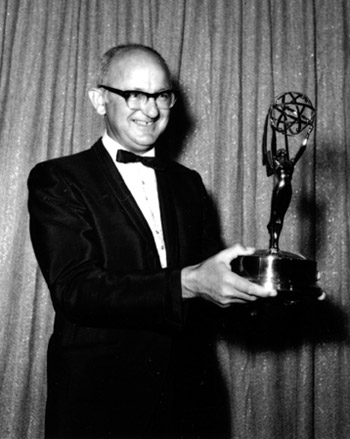Earle Hagen (Earle Harry Hagen)

Born in Chicago, Illinois, as a boy Earle Hagen moved with his family to Los Angeles, California, where he learned to play the trombone in junior high school, and graduated from Hollywood High School. At age 16, he left home to join traveling big bands, playing with Tommy Dorsey, Benny Goodman and Ray Noble. While on the road with Noble in 1939, he wrote “Harlem Nocturne” as a tribute to Duke Ellington and Johnny Hodges. The piece was recorded by several artists, including Johnny Otis, Randy Brooks, Herbie Fields, Sam “The Man” Taylor, Earl Bostic, Charlie Barnet, The Viscounts, King Curtis, Quincy Jones, and David Sanborn. Later, it was used as the theme for television’s Mickey Spillane’s Mike Hammer, and The New Mike Hammer. He began teaching trombone in the 1930s in order to make extra money. In 1940, he went to work for CBS as a staff musician, then enlisted in the military in 1941. Hagen was an orchestrator and arranger for motion picture studio 20th Century Fox in the 1940s and early 1950s, and worked on films like Call Me Madam, Gentlemen Prefer Blondes and Carousel. He began writing for television when he left Fox in 1952 with partner Herbert W. Spencer. The two did the musical score for Janis Paige’s short-lived situation comedy, It’s Always Jan, which aired in the 1955–1956 season on CBS. Hagen met television show producer Sheldon Leonard when he scored the Danny Thomas series Make Room for Daddy.
Hagen’s most ambitious body of work, however, came from his work on I Spy, for which he won an Emmy in 1968. Sheldon Leonard, the producer and creator of I Spy, bucked the trend of using canned music for television shows and instead decided to create original soundtracks for every episode. Since every episode of I Spy was set in a different location, Hagen made liberal use of world music in his soundtracks which were mostly written and performed within the West coast jazz genre. (Hagen did not claim the West coast jazz affiliation for himself, instead inventing the term “semi-jazz,” which he defined as a union of global themes with American jazz.) Other television theme songs that Hagen composed were the themes for My Sister Eileen, The Dick Van Dyke Show, Gomer Pyle – USMC, That Girl (along with I Spy, Thomas and Leonard productions), and The Mod Squad. Earle Hagen was the in-house composer on the fondly remembered 1970s series Eight Is Enough (1977-1981). At the end of his life he continued teaching and wrote books on music arranging and scoring. Sometimes his only fee was a box of golf balls because of his passion for golfing. He wrote one of the first textbooks on scoring, Scoring for Films: A Complete Text. In 2000, he published his autobiography, Memoirs of a Famous Composer Nobody Ever Heard Of. One of his students was fellow Emmy-winning composer and orchestrator Harvey Cohen. Earle Hagen was married for 59 years to Elouise “Lou” Sidwell, a former big-band singer, until her death in 2002. They had two sons, James and Deane Hagen. He married his second wife, Laura (Gunn) Roberts, in 2005. Hagen died of natural causes in Rancho Mirage. He is buried at Desert Memorial Park in Cathedral City, California. Hagen had a Golden Palm Star on the Palm Springs Walk of Stars dedicated to him in 2003. He was inducted into the Television Academy Hall of Fame in 2011.
Born
- July, 09, 1919
- USA
- Chicago, Illinois
Died
- May, 26, 2008
- USA
- Rancho Mirage, California
Cause of Death
- natural causes
Cemetery
- Desert Memorial Park
- Cathedral City, California
- USA


